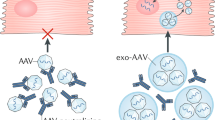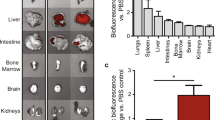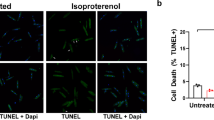Abstract
The treatment of myocardial ischemia using gene therapy is a rather novel but promising approach. Gene delivery to target cells may be enhanced by using double-targeted delivery systems simultaneously capable of extracellular accumulation and intracellular penetration. With this in mind, we have used low cationic liposomes–plasmid DNA complexes (lipoplexes) modified with cell-penetrating transactivating transcriptional activator (TAT) peptide (TATp) and/or with monoclonal anti-myosin monoclonal antibody 2G4 (mAb 2G4) specific toward cardiac myosin, for targeted gene delivery to ischemic myocardium. In vitro transfection of both normoxic and hypoxic cardiomyocytes was enhanced by the presence of TATp as determined by fluorescence microscopy and ELISA. The in vitro transfection was further enhanced by the additional modification with mAb 2G4 antibody in the case of hypoxic, but not normoxic cardiomyocytes. However, we did not observe a synergism between TATp and mAb 2G4 ligands under our experimental condition. In in vivo experiments, we have clearly demonstrated an increased accumulation of mAb 2G4-modified TATp lipoplexes in the ischemic rat myocardium and significantly enhanced transfection of cardiomyocytes in the ischemic zone. Thus, the genetic transformation of normoxic and hypoxic cardiomyocytes can be enhanced by using lipoplexes modified with TATp and/or mAb 2G4. Such complexes also demonstrate an increased accumulation in the ischemic myocardium and effective transfection of hypoxic cardiomyocytes in vivo.
This is a preview of subscription content, access via your institution
Access options
Subscribe to this journal
Receive 12 print issues and online access
$259.00 per year
only $21.58 per issue
Buy this article
- Purchase on Springer Link
- Instant access to full article PDF
Prices may be subject to local taxes which are calculated during checkout






Similar content being viewed by others
References
Gomez-Navarro J, Curiel DT . Conditionally replicative adenoviral vectors for cancer gene therapy. Lancet Oncol 2000; 1: 148–158.
Li SD, Huang L . Gene therapy progress and prospects: non-viral gene therapy by systemic delivery. Gene Therapy 2006; 13: 1313–1319.
Clark PR, Hersh EM . Cationic lipid-mediated gene transfer: current concepts. Curr Opin Mol Ther 1999; 1: 158–176.
Muller OJ, Katus HA, Bekeredjian R . Targeting the heart with gene therapy-optimized gene delivery methods. Cardiovasc Res 2007; 73: 453–462.
Szokol JW, Murphy GS, Vender JS, Nitsun M . Gene therapy in heart and lung disease. Curr Opin Anaesthesiol 2004; 17: 13–20.
Tam SK, Gu W, Nadal-Ginard B . Molecular cardiomyoplasty: potential cardiac gene therapy for chronic heart failure. J Thorac Cardiovasc Surg 1995; 109: 918–924.
Yano M, Hiratsuka M, Nagahiro I, Mora BN, Scheule RK, Patterson GA . Ex vivo transfection of pulmonary artery segments in lung isografts. Ann Thorac Surg 1999; 68: 1805–1809.
Sheikh F, Sontag DP, Fandrich RR, Kardami E, Cattini PA . Overexpression of FGF-2 increases cardiac myocyte viability after injury in isolated mouse hearts. Am J Physiol Heart Circ Physiol 2001; 280: H1039–H1050.
Kelly BD, Hackett SF, Hirota K, Oshima Y, Cai Z, Berg-Dixon S et al. Cell type-specific regulation of angiogenic growth factor gene expression and induction of angiogenesis in nonischemic tissue by a constitutively active form of hypoxia-inducible factor 1. Circ Res 2003; 93: 1074–1081.
Lindquist S, Craig EA . The heat-shock proteins. Annu Rev Genet 1988; 22: 631–677.
Jayakumar J, Suzuki K, Sammut IA, Smolenski RT, Khan M, Latif N et al. Heat shock protein 70 gene transfection protects mitochondrial and ventricular function against ischemia–reperfusion injury. Circulation 2001; 104: I303–I307.
Mack CA, Patel SR, Schwarz EA, Zanzonico P, Hahn RT, Ilercil A et al. Biologic bypass with the use of adenovirus-mediated gene transfer of the complementary deoxyribonucleic acid for vascular endothelial growth factor 121 improves myocardial perfusion and function in the ischemic porcine heart. J Thorac Cardiovasc Surg 1998; 115: 168–177.
Giordano FJ, Ping P, McKirnan MD, Nozaki S, DeMaria AN, Dillmann WH et al. Intracoronary gene transfer of fibroblast growth factor-5 increases blood flow and contractile function in an ischemic region of the heart. Nat Med 1996; 2: 534–539.
Ueda H, Sawa Y, Matsumoto K, Kitagawa-Sakakida S, Kawahira Y, Nakamura T et al. Gene transfection of hepatocyte growth factor attenuates reperfusion injury in the heart. Ann Thorac Surg 1999; 67: 1726–1731.
Dalesandro J, Akimoto H, Gorman CM, McDonald TO, Thomas R, Liggitt HD et al. Gene therapy for donor hearts: ex vivo liposome-mediated transfection. J Thorac Cardiovasc Surg 1996; 111: 416–422.
Schwartz JJ, Zhang S . Peptide-mediated cellular delivery. Curr Opin Mol Ther 2000; 2: 162–167.
Tseng YL, Liu JJ, Hong RL . Translocation of liposomes into cancer cells by cell-penetrating peptides penetratin and tat: a kinetic and efficacy study. Mol Pharmacol 2002; 62: 864–872.
Torchilin VP, Levchenko TS, Rammohan R, Volodina N, Papahadjopoulos-Sternberg B, D’Souza GG . Cell transfection in vitro and in vivo with nontoxic TAT peptide–liposome–DNA complexes. Proc Natl Acad Sci USA 2003; 100: 1972–1977.
Torchilin VP, Levchenko TS . TAT-liposomes: a novel intracellular drug carrier. Curr Protein Pept Sci 2003; 4: 133–140.
Khaw BA, Mattis JA, Melincoff G, Strauss HW, Gold HK, Haber E . Monoclonal antibody to cardiac myosin: imaging of experimental myocardial infarction. Hybridoma 1984; 3: 11–23.
Torchilin VP, Klibanov AL, Huang L, O’Donnell S, Nossiff ND, Khaw BA . Targeted accumulation of polyethylene glycol-coated immunoliposomes in infarcted rabbit myocardium. FASEB J 1992; 6: 2716–2719.
Khaw BA, Torchilin VP, Vural I, Narula J . Plug and seal: prevention of hypoxic cardiocyte death by sealing membrane lesions with antimyosin-liposomes. Nat Med 1995; 1: 1195–1198.
Torchilin VP, Narula J, Halpern E, Khaw BA . Poly(ethylene glycol)-coated anti-cardiac myosin immunoliposomes: factors influencing targeted accumulation in the infarcted myocardium. Biochim Biophys Acta 1996; 1279: 75–83.
Dass CR, Choong PF . Selective gene delivery for cancer therapy using cationic liposomes: in vivo proof of applicability. J Control Release 2006; 113: 155–163.
Dass CR . Lipoplex-mediated delivery of nucleic acids: factors affecting in vivo transfection. J Mol Med 2004; 82: 579–591.
Sou K, Endo T, Takeoka S, Tsuchida E . Poly(ethylene glycol)-modification of the phospholipid vesicles by using the spontaneous incorporation of poly(ethylene glycol)-lipid into the vesicles. Bioconjug Chem 2000; 11: 372–379.
Ishida T, Iden DL, Allen TM . A combinatorial approach to producing sterically stabilized (Stealth) immunoliposomal drugs. FEBS Lett 1999; 460: 129–133.
Gupta B, Levchenko TS, Mongayt DA, Torchilin VP . Monoclonal antibody 2C5-mediated binding of liposomes to brain tumor cells in vitro and in subcutaneous tumor model in vivo. J Drug Target 2005; 13: 337–343.
Torchilin VP, Levchenko TS, Lukyanov AN, Khaw BA, Klibanov AL, Rammohan R et al. p-Nitrophenylcarbonyl-PEG-PE-liposomes: fast and simple attachment of specific ligands, including monoclonal antibodies, to distal ends of PEG chains via p-nitrophenylcarbonyl groups. Biochim Biophys Acta 2001; 1511: 397–411.
Torchilin VP, Rammohan R, Weissig V, Levchenko TS . TAT peptide on the surface of liposomes affords their efficient intracellular delivery even at low temperature and in the presence of metabolic inhibitors. Proc Natl Acad Sci USA 2001; 98: 8786–8791.
Verma DD, Hartner WC, Levchenko TS, Bernstein EA, Torchilin VP . ATP-loaded liposomes effectively protect the myocardium in rabbits with an acute experimental myocardial infarction. Pharm Res 2005; 22: 2115–2120.
Acknowledgements
This research study was supported by the NIH grant RO1 HL55519 to VPT.
Author information
Authors and Affiliations
Corresponding author
Rights and permissions
About this article
Cite this article
Ko, Y., Hartner, W., Kale, A. et al. Gene delivery into ischemic myocardium by double-targeted lipoplexes with anti-myosin antibody and TAT peptide. Gene Ther 16, 52–59 (2009). https://doi.org/10.1038/gt.2008.135
Received:
Revised:
Accepted:
Published:
Issue Date:
DOI: https://doi.org/10.1038/gt.2008.135
Keywords
This article is cited by
-
Plasma anti-myosin autoantibodies in the diagnosis of necrotizing enterocolitis
European Journal of Pediatrics (2023)
-
Engineering liposomal nanoparticles for targeted gene therapy
Gene Therapy (2017)
-
Gene therapy for cardiovascular disease mediated by ultrasound and microbubbles
Cardiovascular Ultrasound (2013)
-
The Clinical and Diagnostic Significance of Anti-myosin Autoantibodies in Cardiac Disease
Clinical Reviews in Allergy & Immunology (2013)
-
Diseases originate and terminate by genes: unraveling nonviral gene delivery
Drug Delivery and Translational Research (2013)



